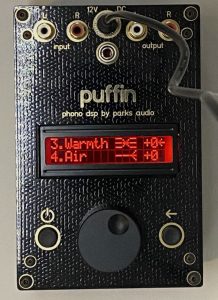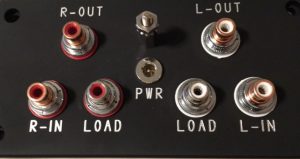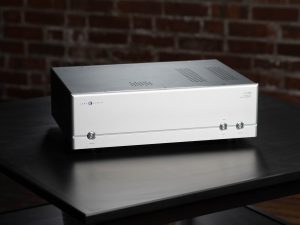The Dutch company Mola Mola was founded in 2012. Its founders were Bruno Putzeys and Jan-Peter van Amerongen; both knew each other from their work for Hypex. Their first products, a line preamplifier and a power amplifier with nCore modules operating in class D, were presented at the 2012 Munich High End Show. We test the company's latest product, the Lupe phono preamplifier.
Mola Mola is an audio company different from most companies we know. That's what most of them say about themselves, but only a few really are. First of all, it was founded as a commercial project initiated by two people who are known for their fundamental research in audio—and this is an absolutely unique thing. The first of the founders is a long-time designer of amplifier circuits, while the second is the founder of Hypex, a company that makes components for audio equipment, where the former worked.
Bruno Putzeys, as he is referred to, is the engineer responsible for the creation of three most interesting amplifier circuits working in class D. The first is the UcD (Universal class D), the second is the Ncore, both produced by Hypex, whose head is Jan-Peter van Amerongen, Putzeys' partner at Mola Mola, and the third is the Eigentakt, his latest idea, developed with Lars Rubio (formerly TacT Millennium), and which they offer as part of the company Purify (https://purifi-audio.com).
Putzeys, born in 1973, that is, a peer of mine who worked for Philips for ten years, where he developed the UcD module in his spare time, is an extremely creative, excellent design engineer who also has a knack for business. In addition to Mola Mola and Purify, he is also the co-founder of such well-known companies as Kii Audio (www.kiiaudio.com) which focuses on active loudspeakers, and Grimm Audio (www.grimmaudio.com) which offers top audio file players. For one man, that's more than enough.
Lupe
Lupe phono stage was officially unveiled at the 2023 Munich High End (see the report HERE). It was born as a development of the optional module for the Makua line-level preamplifier, later also available for the Kula integrated amplifier:
What was conceived as a simple RIAA addition to the Mola Mola Makua preamplifier (also used for the Kula integrated amplifier) has quickly evolved into the quietest and possibly most versatile phono preamplifier ever built. The MC/MM inputs are optimized in terms of current and voltage noise, respectively.
Unlike the more common solution, in which the MC main amplifier feeds the MM stage, the two stages are fully independent, realizing an equally short signal path for both. Input gain is switchable in 5 dB steps within a 40 dB range. Input loading and capacitance are switched individually. Available EQ settings cover virtually all known speeds, including 78 RPM.
An archival grade phono stage, https://www.mola-mola.nl/phono.php, accessed 15.11.2023.
It is a compact size unit, which suits me personally; it measures 200 x 110 x 320 mm and weighs 5.1 kg. The latter figure is understandable, since this is a manufacturer developing its own high-tech switching-mode power supplies, and one of those designs can also be found here. And that means dispensing with large and heavy transformers. The use of a switched-mode power supply did not worsen the measurable performance, in fact it improved it. As we read in the quoted passage, Putzeys speaks of the "quietest," that is, contributing the least noise from itself, phono preamplifier "ever built." And he knows what he's talking about, because he's almost a measurement fanatic.
When the company materials talk about an optional board for the preamplifier, which we will now also find in the Lupe, they mean it literally. When you look inside the unit, you'll find exactly the same board in the center of the layout, to which input and output circuits have been added, separately for the left and right channels, and a large power supply module. This is a modern product created by the man proficient in modern techniques and solutions, so its components were soldered using surface technology. The exceptions are the through-hole polypropylene Wima capacitors in the equalization section. The circuit is fully balanced.
On the circuit board you can see many relays, one sets the parameters with, and transistors—this is where the signal is amplified. The manufacturer points out that, unlike other phono preamplifiers, Lupe offers separate gain paths for MM and MC cartridges. The basis is almost always an MM amplification and equalization circuit to which either an active or passive (step-up) gain module is added. The transistors in question are soldered on small auxiliary boards plugged into the main board—reminiscent of Marantz's HDAM modules.
The Dutch preamplifier offers three separate RCA inputs, the third of which is duplicated—in addition to the RCA jacks there are also XLRs. There are also two outputs - RCA and XLR. Each input can be separately set, both in terms of gain and input loading; for MC cartridges it's impedance, and for MM cartridges capacitance. The settings are stored in internal memory, so they will be available even when the unit is disconnected from the mains. The user can activate a subsonic filter to protect the speakers from distortion; the DC filter also activates when the device detects a high DC voltage at the input.
The user adjustable parameters are:
- Input name
- Active output (RCA, XLR)
- Input loading: 60, 100, 150, 250, 400, 470, 650 Ω, 1 kΩ (MC) ⸜ 18-120 kΩ (MM).
- Capacitance: 50-380 pF (MM only)
- EQ: RIAA, Decca, Capitol, Columbia, etc. - 47 (!) different presets pre-stored in the unit's memory
- Gain: 52-87 dB (MC), 45 and 50 dB (MM).
- Mono/stereo
- Left and right channel phase inversion
- Subsonic filter
And now, perhaps most importantly in this section: parameter changes are made using a custom app, which we can download to a tablet or smartphone. We connect with Lupe via Bluetooth—I checked, the connection is stable and reliable. In the application we can change not only the loading for a cartridge, but also choose the equalization, and even create our own.
There is still a debate in the audio world about the sensibility of such solutions, and some go so far as to claim that the existence of various curves, such as Decca, Teldec, EMI, 30s and 40s, etc., is a myth, not a reality. Without settling the issue, however, it is worth knowing that, if you're interested, the Mola Mola preamplifier is ready for experimentation.
The device is small, but incredibly mechanically stable. It owes this to a massive aluminum chassis with doubled panels and non-parallel panels. The wavy top and concave front are part of the so-called "visual identity" of the brand. It is part of the "marine ecosystem" in which all its products are immersed—I don't know where it came from but it fits. Already its name and logo, depicting a fish in Polish systematics known as "samogłów" or sunfish (or... Mola Mola). It is the world's largest bony fish with a peculiar body structure resembling a floating head. The fish can grow up to three meters and weigh up to two tons (!). Makua, and this is the name of the brand's preamplifier, means Mola Mola, but in the Hawaiian language.
The name of the Kaluga amplifier, on the other hand, is one of the varieties of sturgeon, a fish that is as unusual as the sunfish. As we read in Wikipedia, it is one of the oldest species of fish that live in the world today. The oldest traces of sturgeon date back to the Cretaceous period, more than 135 million years ago. In addition, it is a long-lived species. Sturgeons can live up to 100 years. And then there's a DAC called Tambaqui—it's one of the most aggressive subspecies of piranha. Lupe is, I assume, the name of a mythical fish that inhabited the Lether River and Letheras canals, and whose only food was supposed to be humans.
Bruno Putzeys, when asked about this unusual nomenclature by Martin Colloms, replied that he originally wanted to call its products "Preamplifier," "Power Amplifier," and so on, but its Japanese distributor forced a more creative approach to it:
"I probably thought at the time of the Japanese love of all kinds of aquatic organisms, usually eaten raw," so he reached out to Wikipedia. But, he says, it took him as long as two days to find the right names— "You wouldn't believe how mundane the names of most fish are."
Andrew Everhard/Martin Colloms, Mola Mola Tambaqui, HiFiCritic, 2020, Apr/May/Jun, p 11.
The front of the device features an easy-to-read display, that seems to be an AMOLED one, which shows all settings. It turns off after some time and then only two white LEDs remain visible—one indicating the operating mode and the other the selected input. If it flashes, it means that you have pressed the button selecting a particular input twice and activated the "mute" mode.
The device stands not on feet, but on rigid, elongated rails with rubber glued underneath them. We can control it with an app, but also through an aluminum remote control. Lupe comes to us packaged in a sturdy plastic travel case.
SOUND/HOW WE LISTENED
The Mola Mola Lupe preamplifier was tested in the High Fidelity reference system. It stood on a carbon fiber top shelf of the Finite Elemente Master Reference Pagode Edition Mk II rack, and was compared to my long-time reference, the RCM Audio Sensor Prelude IC, from which the signal was forwarded with a Crystal Cable Absolute Dream interconnect.
The signal source was a Rega Naia turntable with an Aphelion 2 cartridge, standing on the same rack as the preamplifier under test. The Lupe was powered using the Harmonix X-DC350M2R Improved-Version cable.
Albums used in the test | a selection
Julie London, Julie is Her Name. Vol. 1, Liberty Records LPR 3006, LP (1955).
Frank Sinatra, Sing and Dance with Frank Sinatra, 70th Anniversary Edition, Columbia/Impex Records IMP6036, 180 g LP (1950/2020).
Benny Goodman Orchestra, Benny Goodman Orchestra Feat. Anita O'Day, Jazzhaus 101704, "Bigbands Live" series, 2 x 180 g LP (2011/2013).
Benny Carter, Jazz Giant, Contemporary Records/Analogue Productions AJAZ 7555, "Top 100 Jazz, 45 RPM Limited Edition #0404", 2 x 180 g, 45 rpm LP (1958/?).
De-Phazz Jazz Quartet feat. Joo Kraus, Live at Villa Belvedere, ATR ATRP045, 180 g LP + Test Press (2023).
Diana Krall, This Dream Of You, Verve Records B0032520, Test Press LP (2020).
Andreas Vollenweider, Caverna Magica (...Under The Tree - In The Cave...), CBS 25 265, "Halfspeed Mastered," LP (1982/1983); more HERE.
Brendan Perry, Ark, Cooking Vinyl/Vinyl 180 VIN180LP040, 2 x 180 g (2011).
The Beatles, Sgt. Pepper's Lonely Hearts Club Band, Apple/Gold Note DT-01, "Limited Edition No. 82/500", 180 g LP (1967/2016).
Skalpel, Transit, PlugAudio PL02, 2 x 180 g LP (2014).
What would you expect from a device, one of the designers of which is a man who specializes in amplifiers working in class D? Flying by stereotypes we would say: precision, selectivity, but also a certain dryness and "mechanicalness." For in the perfectionist audio industry, Class D still has these kinds of connotations. Meanwhile, as I've been writing about for years, good amplifiers of this type, loaded in the right way, are warm, smooth—in term of tone and sound-building they resemble tube devices. Such is also the case with the Lupe preamplifier.
Equally "true" is also the second stereotype, associating semiconductors with a not very saturated and dry, perhaps even a clear presentation. For years I have been answering questions, responding to eyebrows raised in surprise, and sometimes even reacting to the taunts of those for whom my admiration for RCM Audio, both in terms of the tiny Sensor Prelude IC preamplifier I've been using for a dozen years, and the incredible, powerful Big Boy. These are solid-state devices, and what's more - based on integrated circuits. And yet...
It ran through my head as soon as the stylus dropped on the beginning of Julie London's Julie is Her Name. Vol. 1. When Barney Kessel played a brief intro on guitar as London sang "Now you say you're lonely...", I knew I was dealing with the same caliber as other companies' top-of-the-line equipment, and—just as importantly for me—with a similarly built sound to the one I know from my preamplifier and which is the right one for me.
The Lupe plays with an incredibly saturated sound that is packed with information. No matter how good my preamp would be, no matter how well I knew it - and I've tested many top phono and turntable preamplifiers at home—the Dutch device immediately showed what could be done better. And not "a little better," but "much better."
The Mola Mola plays deeply, both in terms of timbre and depth of sound. It also brilliantly builds a three-dimensional body that leans slightly in listener's direction. Once, however, we think we have an instrument or vocal in question at our fingertips, it turns out that it's not, that the phantom image in question is actually placed behind the line connecting the speakers, and the proximity is derived from the large body and depth of that projection.
The same was true of Frank Sinatra's voice from the Sing and Dance with Frank Sinatra album, beautifully produced by Impex Records on the 70th anniversary of its release. Sinatra's voice was succinct, strong, big. At the same time, I noticed that his accompanying instruments were more "present" and better described with the Lupe than with my preamp. Not just that, also better than with most preamplifiers I've heard at my place, regardless of price.
And it's all about the subtle distinction between the warm vocals and the bright, dynamic, highly energetic sound of the brass instruments. Even the percussion, usually blended into the background, had superbly, though still rather quietly, drawn cymbals, and the double bass gained in efficiency in controlling the rhythm. The tested preamplifier differentiates between small and large signals without a problem, differentiates between warm and cold tones effortlessly, and excellently differentiates the dynamics of what is smaller from what is larger.
Perhaps that's why it's so good for loud listening to music, and you can really do that with the knob turned hard to the right, as well as when listening very quietly. It's so, that when playing an album like Benny Carter's Jazz Giant we momentarily feel the rhythm and want to feel it harder. So we turn up the volume little by little. But in a moment we catch ourselves adding more and more decibels, and before long we are playing really very loud. On the other hand, playing music in the background is equally satisfying, even then you can hear what's so special about this device.
It was able to showcase Julie London's veiled, dark vocals on one hand, really warm, and in a moment hit me with the alto saxophone and tenor saxophone of the next album's leader, Ben Webster, and then Frank Rossolino's trombone. Even Andre Previn's piano was clear and pure, though noticeably quieter than the other instruments. Because Lupe differentiates their volume and loudness also within a recording, not just when comparing different records. Interestingly, Kessey's guitar wasn't particularly clear, blending in with the sound of the piano, showing that this device doesn't focus on bringing out details where they shouldn't be.
The Dutch preamplifier plays in an equally balanced way not only analog recordings, but also digital ones, such as Diana Krall's from the test press of the This Dream Of You album. It wasn't as smooth, as tonally deep as the previous recordings, but it's still a top-notch realization and Lupe confirmed that. It also added something to the sound that the equipment usually misses, namely the bodies of instruments set up by the sound engineer further down the stage—their weight, mass, etc. The drum brushes on Krall's album had both a bright attack and a dark fill. That is, they were clear, distinct, but also fulfilled their primary role, that is, they formed the background for the vocals and piano.
It may not be clear from what I wrote, but the preamplifier in question offers an above-average-sized soundstage. Above average not by its over-the-top momentum, nor by its magnification of instruments. The Lupe does something that happens rarely in my system, and should happen much more often: it shows precise bodies in excellent relation to other ones, in a clear, selective way, and yet the sound seems smooth, almost mellow.
Therefore, the opening sequence of Andreas Vollenweider's album Caverna Magica (...Under The Tree - In The Cave....), i.e., the "conversation" through the cave, the scuffing of feet in the pebbles outside its entrance, and then the opening of its massive interior, was all clearer and better laid out in space than with most RIAA curve-correcting devices I've heard at home.
And underneath lay selective bass. Low sounds are reproduced by the Lupe similarly to the top of the band, that is, in a clear way, but with an emphasis on warm sustain. On the one hand, the device doesn't add bass, doesn't "dissolve" recordings in thick syrup, but it doesn't lighten them either. Interestingly, those with less bass are not crippled by it, and those with a strong synth line on the lower end of the band, let it be Brendan Perry's Ark, will get its control and precision, without being overly contoured. Likewise, by the way, with the rather soft-sounding bass from the De-Phazz Jazz Quartet disc. And I hate stiffening of the attack as much as the bright treble.
MUSIC REVIEW | Our Albums Series
De-Phazz Jazz Quartet feat. Joo Kraus, Live at Villa Belvedere. ATR ATRP045, 180 g LP + Test Press. 2023
De-Phazz, whose name is an acronym for DEstination PHuture JAZZ, was formed in 1997 by Pit Baumgartner in Heidelberg. A lot of musicians played in it, and the lineup is quite fluid. The permanent members are: Pat Appleton, Barbara Lahr, Karl Frierson and Oli Rubow. Live at Villa Belvedere is another album by this German band, this time recorded as a quartet, by the Sommelier Du Son crew for ATR Publishing.
This micro label is jointly run by a married couple, Dirk Sommer and Birgit Hammer-Sommer, and specializes in all-analog direct-to-two-track (AAA) recordings. In this duo, Birgit is responsible for operating (analog) tape recorders, a function that used to be called tape-op (tape operator), and Dirk is the sound engineer. He is also the editor-in-chief of HiFiStatement.net magazine and both are our friends.
It seemed that the Garage Pompeuse album of this band, presented by us at last year's Audio Video Show 2022, was an exception. This is a band that plays music in which samples are an important part, as well as studio production involving catching up and modifying recorded tracks. Meanwhile, the sessions conducted by Dirk are purist "live in the studio" recordings, that is, at 100%, with all the musicians playing at the same time, mixed live and recorded straight to two tracks on an analog reel-to-reel tape recorder. As it turns out, the album, originally recorded in 2015, found its follow-up in Live at Villa Belvedere.
The material for the album was recorded at Villa Belvedere, a beautiful palace in Eltville on the Rhine, restored some time ago by the Italian design studio AK Architetetti (HERE). The recording took two days, on June 31st and July 1st 2023, and took place with an audience, which we hear, however, only in the album's closing track "Trash Box." Each of the tracks was recorded several times, but as Birgit said in Warsaw during our joint presentation, most of the ones that ended up on the album are first takes.
The recording was minimalist, with a few microphones, a small mixing table and two Studer A810 tape recorders running at 38 cm/sec. Dirk mixes using an Acoust P100 console with added Haufe transformers on all inputs and outputs. He does the listening with headphones and a Bryston BMP2 headphone amplifier.
He uses classic microphones such as the Neumann KM 184 and AKG D12 in an active version for drums, the bass was recorded by a hybrid tube-transistor (FET) microphone, and for the Fender Rhodes' piano he used two microphones, a Neumann and a Microtech Gefell. For the trumpet, a classic Neumann U 47 microphone was used. Mastering of the material was done in Vienna by Christopher Stickel who was nominated for a Grammy this year.
The album was pressed in only 1500 copies, and we also had its Test Press for listening. Files are also available for purchase—the session was recorded simultaneously on a Nagra hard disk recorder.
The sound is exceptionally sublime—this is probably the best description of what I heard from the Rega Naia turntable with the Aphelion 2 cartridge and the Mola Mola Lupe preamplifier. Dark, but with lots of information, dense, but not "nasal." I really liked the sound of the Fender piano, as it had a soft attack, yet compact sound. I don't like it when it is artificially hardened. This is usually done when we have too little information and want to emphasize the presence of the instrument in the mix.
But also the other instruments, including the wonderful trumpet with a muffler, had a similar expression. That is, very "personal" on the one hand, you could hear that it was a recording in a relatively small room and with closely positioned microphones, but at the same time it was clear that nothing was suppressed and that the instruments "heard" each other. These, so-called "leaking," are the basis of good sound of classic jazz albums from the 1950s and 1960s.
The music we get belongs to the trend collectively called smooth jazz. So let's not expect innovation or particular creativity. Because that's not what this playing is about. The Sommers' recording reveals the warmth and density of this music without aspiring to be anything other than simply relaxing material for an evening, which in addition sounds great—it sounds in a very natural way.
Summary
Listening to The Beatles' album Sgt. Pepper's Lonely Hearts Club Band, released by the Italian company Gold Note in a limited edition of 500 copies, pressed contemporaneously from the original analog production tape sent in 1967 by the publisher to some local pressing plant, what hit me at the very beginning came back to me: perfect tonal balance, extraordinary resolution and sophistication.
The latter allowed me to conduct listening sessions in exceptional comfort. But not because it allowed me to sleep, but because I heard more, and I understood it better, and I didn't have to strain, focus, analyze the sound in search of specks of "gold." With Lupe I sat down in front of the system and it presented its class immediately in a clear way.
On the one hand, it's a preamplifier that meets the requirements of a "tool," i.e. gives you a set of features necessary to quickly evaluate the sound and describe it. But at the same time, it's a product that doesn't step over the line dividing what's exciting and new from what's irritating and annoying. Because it is a sound, in fact, with a silky finish, dense and deep. With perfectly controlled band extremes, but drawing our attention primarily to its midrange. And with a powerful, beautifully arranged space.
Add to that phenomenal energetic performance, and it is one of the best phono preamplifiers on the market, regardless of price. If this unit were to be packaged in a large enclosure, add an external power supply, and sold under a brand known for its phono products, Lupe could cost two or even three times as much and still be a star. It fully deserves our RED FINGERPRINT.
Technical data (according to the manufacturer)
- Noise (MC): 0.35 nV/rtHz
- Noise (MM): 0.9 pA/rtHz
- Sensitivity: variable from 30 μV to 5 mV
- THD, IMD distortion: unmeasurable
- RIAA compliance: +/-0.1 dB
- Subsonic filter: -3 dB (20 Hz)
- Power consumption: 25 W
- Dimensions (W x H x D): 200 x 110 x 320 mm
- Weight: 5.1 kg
- Price (when reviewed): PLN 36,900
Mola Mola
Kattegat 8, 9723JP Groningen
NETHERLAND
MADE IN NETHERLAND
Provided for test by SOUND SOURCE https://soundsource.pl
text by WOJCIECH PACUŁA
translation by Marek Dyba
images by High Fidelity






















































